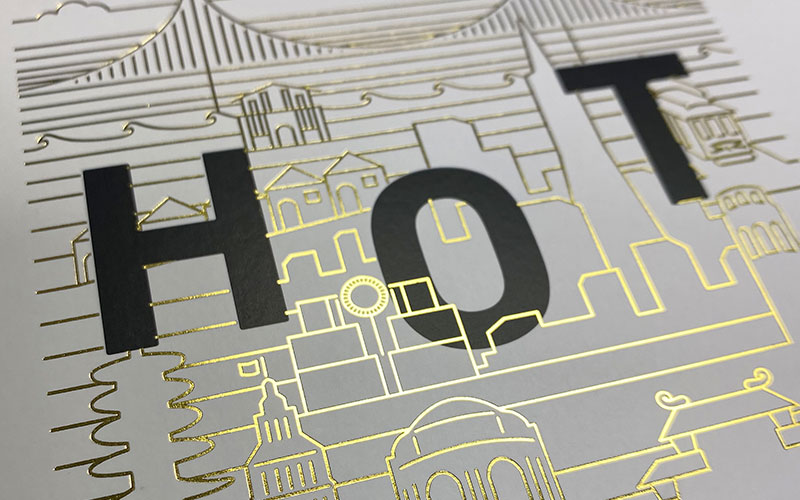
By Jeff Peterson, executive director, Foil & Specialty Effects Association
When I have presented at tradeshows and conferences on behalf of the Foil & Specialty Effects Association (FSEA), I’ve told audiences that it wasn’t too many years ago that when a brand owner or printer wanted to include a metallic decoration on printed material, the only real choice was hot foil stamping.
Today, there are many other choices in the marketplace, including cold foil transfer, toner-based digital foiling and polymer-based digital foiling, as well as pre-metallized paper and/or board.
Although many of our FSEA members have had concerns about the emergence of other metallic decorating processes – especially those who have relied on more traditional hot foil stamping – what actually has happened is that the addition of these new processes has helped market and showcase the use of metallic decorating, creating more activity for all the different techniques. In addition, as I will explain in more detail throughout this article, each type of metallic decorating process has advantages and disadvantages, and, in most cases, fits specific applications.
Metallic decorating and sustainability
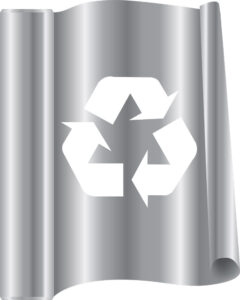
Before we discuss metallic finishes in detail, I want to address the sustainability issue with metallic decorating processes. There continues to be confusion with brand managers and consumers who want to include all metallic finishes into one category. As our industry is aware, there is a huge difference between transfer metallic foil processes and foil laminated board/paper in terms of recyclability. We must educate brand managers that hot, cold and digital foils are applied through a transfer process and the plastic film carrier is not applied to paper/board. With foil laminated board, the metallic finish is applied to the board along with the plastic film, creating a more difficult product to recycle or repulp.
FSEA recently commissioned a new study entitled “Repulping of Foil Decorated Paper.” The study demonstrated that transfer foil decorated paper or board does not create problems in the recyclability/repulpability of paper or board in a common repulping process. Again, it is important that we educate those who ask about the difference in these processes and promote transfer metallic processes as a sustainable choice when selecting a metallic finish for printed materials. If readers are interested in the new study, contact me for a copy of the report.
It has been suggested – and I am in favor of developing a plan as an industry – to begin using the word “transfer” when selling and discussing the use of transfer foil processes such as hot, cold and digital foil decorating. In other words, FSEA members and others would begin to refer to it as hot transfer foiling or hot transfer metallic, rather than hot foil stamping. Cold foil would be referred to as cold foil transfer, and digital foiling would be digital foil transfer. A strategic plan to begin identifying transfer processes so they are not grouped with foil laminated paper/board can help in the education process to distinguish between the two. FSEA will be providing more details on this and other sustainable solutions in the coming months.
Hot foil stamping (hot transfer metallic)
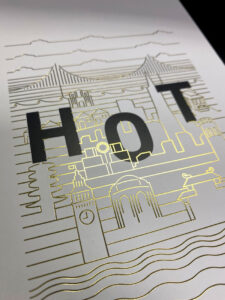
foil and emboss in one pass.
As discussed earlier, hot foil stamping has been the conventional way to apply foil for decades, and it still is the most popular choice of metallic decorating worldwide. By far it is the most versatile process when applying foil – meaning it has a much broader range of paper stocks it can work on; it encompasses the broadest range of foil colors and adhesives; and it provides the ability to create finished decorated looks that other foil processes cannot, including foil and embossing in one pass and refractive (micro-etched) patterns onto the surface of the foil. It also provides the greatest array of equipment choices in the marketplace to foil stamp different sizes of sheets and substrate choices.
The disadvantage of hot foil is the cost of the tooling – the foil stamping dies (engravings) needed to apply the foil. With both cold and digital foil processes, there are virtually no tooling costs to apply. However, the tooling cost is only relative to the size of the foil job; although, if the run length of a job is small, it can be a significant cost. Hot foil stamping also is a secondary process that happens once a sheet is printed. This can add time to the job and, of course, costs.
Cold foil transfer (cold transfer metallic)
Cold foil transfer for sheet-fed applications is not new by any means, but it has become more popular for many applications due to the advent of better foil products that run faster and keep a metallic sheen when they are applied. Improved adhesives and technology in cold foil transfer machinery also have been a part of growth in recent years.
The main advantage of cold foil transfer is in its elimination of a secondary process. Cold foil can be applied in the first two stations of an offset press, and then the additional stations on the press can apply CMYK over the top of the foil, creating virtually any color under the rainbow. Cold foil also does not have to utilize tooling (dies). It is an excellent choice for projects where significant foil coverage is required. In those instances, cold foil transfer is a great alternative to foil laminated board, where the entire sheet has a metallic finish. In most cases, white opaque ink is needed for certain areas on the sheet (especially with folding carton work), adding an additional station and printing plate needed on the press. In addition, white ink is notorious for being difficult to work with. Cold foil transfer allows the areas that need to be white to be “knocked out” of the foil design, eliminating the need to use white ink.
From a disadvantage standpoint, cold foil transfer does not provide the full versatility of hot foil stamping as it relates to the paper stocks. Although there has been some success recently with cold foil on uncoated stocks, it is most effective on coated papers. Cold foil also is not usually the best choice when foil is required only in specific areas of a design. Because the foil is running through the press at high
speeds, there is less control of the foil. If the design doesn’t call for a large usage of foil, hot foil stamping may be a better choice.
Both hot foil and cold foil transfer processes are better choices for medium- to larger-sized runs, mainly due to the set-up time required with cold foil and the higher tooling costs of hot foil projects. Smaller runs often are better suited for digitally applied foil.
Digital foiling (digital transfer metallic)
Digital foiling processes have caused some confusion in the industry because there are two processes identified as digital foiling – one which uses printed toner as the adhesive for the foil and one that uses an inkjet-applied polymer as the adhesive. FSEA and its Foil Cheat Sheet (which was produced in cooperation with PaperSpecs) has identified the two processes as toner-based digital foiling and polymer-based digital foiling. Let’s take a look at each type.
Toner-based digital foiling
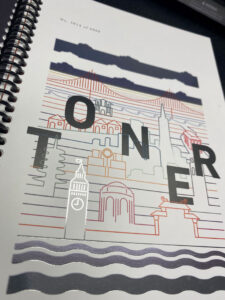
This is a simple two- or three-step process utilizing a rich black toner from a digital printing press (not inkjet) as the adhesive and then using a heated lamination process to adhere the foil to the toner images. This process can be referred to as “sleeking.”
A key advantage of this process is the lack of any tooling or dies needed to create the foil image, making it a great choice for shorter runs or prototypes. Because a digital printer can be used to print out the images that will include foil, every sheet can be personalized or include different information in foil without adding costs. Personalized invitations or gift cards are a great application for toner-based digital foiling. In addition, using a silver metallic foil, the foiled sheet can be sent back through a digital printing press where all types of metallic hues can be created by printing over the top of the foil layer.
The primary disadvantage of toner-based digital foiling is that it is not a feasible option for larger runs of foil. Because it takes multiple steps to create an image, it is best suited for shorter runs and would not be recommended for any type of large-run application. It also is limited to mostly coated stocks or stocks specifically created for digital applications.
Polymer-based digital foiling
There now are specific machines on the market today that can apply a polymer through an inkjet process to a printed piece; then the foil adheres to the areas where the polymer has been applied. Adding a thicker layer of adhesive also allows for the foil to be raised above the paper level, providing an embossed look to the foiled image. Sensors on the digital decorating inkjet press can ensure registration of the print and polymer adhesives. Some systems in the marketplace apply the polymer and foil in one pass and others apply the polymer prior to the foil being laminated in a process similar to toner-based digital foiling.
One advantage of this process – as with toner-based digital foiling – is that dies or plates are not needed to apply the foil; instead, it is done through an inkjet process. As with the toner-based process, personalization is possible using foil where this is not a feasible option for hot or cold foil processes. Another advantage of polymer-based digital foiling is that a clear polymer (coating) can be applied in a separate pass over the foil or in other areas on the printed piece, offering specialty spot coatings and foil in one design to create spectacular looks for all types of printed materials.
The process produces spectacular work, but it is suited for targeted application types. One of the disadvantages of polymer-based digital foiling is that it is best suited for small- to medium-sized runs – it is not set up for a 50,000- to 100,000-sheet run. This type of foil decorating also is not recommended when applying large areas of foil due to how the adhesive is applied (digital inkjet). Because of this limitation, it is not commonly overprinted with 4-color process. And, as with toner-based digital foiling, there are limitations on paper stock – coated stocks or stocks designated for digital printing are best suited.
Foil substrates
There still are many applications, especially in the folding carton arena, where foil laminated or foil transfer paper/board is popular. Foil laminated board often is used for very large runs where the carton or sheet has heavy coverage of a metallic finish.
The obvious advantage of using a foil laminated substrate is the ability to create the needed metallic finish in one pass on an offset press without the use of a retrofitted cold foil unit or foil stamping the sheet in a separate process. This can provide cost savings for very large runs where the metallic finish is used throughout the design of a carton or label.
However, there are several drawbacks to using a foil laminated substrate. First, the cost of the material can become quite expensive. It can be more cost efficient to add cold foil inline on standard SBS stock for heavy coverage or to foil stamp in a second pass when the metallic finish is to be added in specific areas only, especially in medium to large runs.
In addition, when using a foil substrate, there usually are areas that need to have a white background, especially on cartons and labels. In those cases, white opaque ink must be applied, which means a separate station on the printing press must be used to apply it. As mentioned previously, white opaque ink is not easy to work with and can cause many challenges on press.
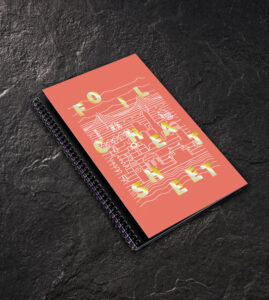
Last, but certainly not least, is the sustainability issue with foil laminated substrates that was raised earlier. The Foil & Specialty Effects Association has invested in two separate studies and will be conducting more in the future to demonstrate and reinforce that transfer foil decorated paper and board do not create problems in the recycling/repulping of paper and/or board in a common repulping process. This includes transfer hot foil, cold foil and digital foil processes. This does not include foil laminated products, since plastic film is included with the metallic finish. This is a key difference between the processes and must be considered when determining which metallic decorating process should be used in the production of a metallic finish.
Selecting a metallic finish for printed materials is an entirely different adventure than it was several years ago, with many factors to consider. It is important to look at all factors involved to choose the right process for the right application. FSEA is available for consultation when there are questions. It’s a jungle out there!
Jeff Peterson, FSEA executive director, has been involved in the foil industry for more than 30 years. He has written numerous articles for FSEA’s official magazine, PostPress, and other industry-related publications. He also has conducted seminars at print industry events, including GRAPH EXPO, PRINTING United and Odyssey Expo.
Much of the information found in this article is summarized and illustrated with foil decorated examples in FSEA’s Foil Cheat Sheet. This half-sized guide is available through FSEA by visiting www.fsea.com.

